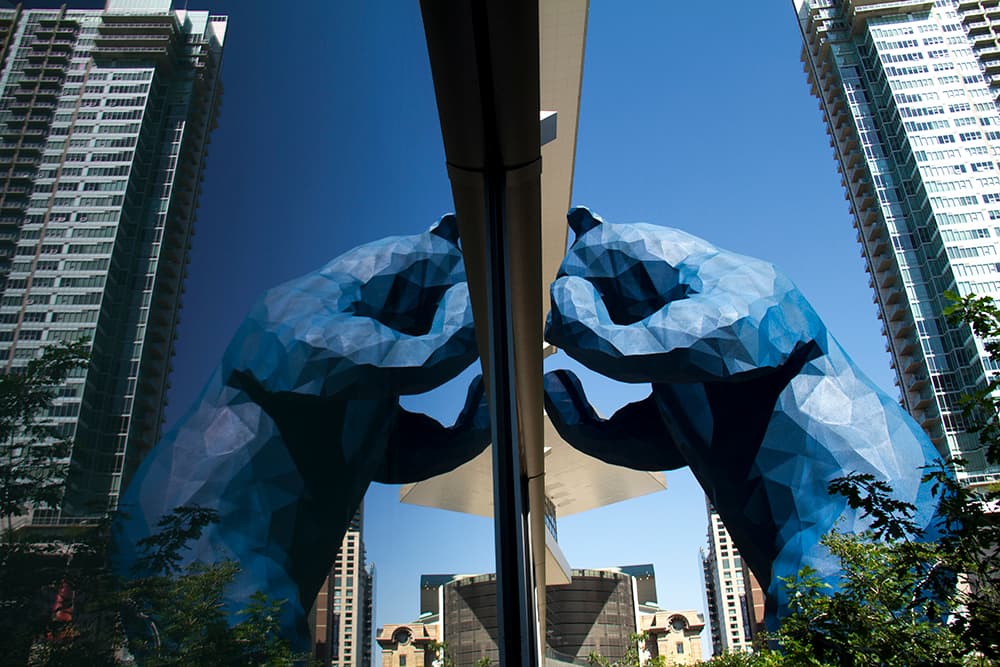Why does a demonic horse guard an airport terminal stocked with surreal paintings and a faux-ancient temple in Denver?
Because that's what happens when you hand out millions of dollars and invite artists to have a field day.
It's an example of what I'll call the Denver Wealth-Weirdness Corollary: The same wave of development that has filled Denver with "fugly" apartment complexes and lookalike dudes also has indirectly sprayed the city with public art that is by turns unusual, controversial, ugly and inspirational.
Here's how it works, along with the price tags on every modern piece in the city's collection, which includes about 400 pieces total. (Scroll to the bottom.) Plus, look for a bit of little-known trivia on the big blue bear and other faves and/or least faves.
Price tag: $300,000

Let's stick with DIA. The airport cost billions of public dollars to build. Knowing that this huge project was coming, former mayor Federico Peña ordered in 1988 that 1 percent of the budget for all new, publicly accessible municipal projects go toward public art near the construction site.
As a result, Denver installed an unprecedented $8 million of public art in 1994, almost all of it at the airport.
It's continued that way ever since. Every time there's a big project, the city has to figure out how to spend all that tasty, tasty art money -- about $32 million in total by now.
"We just move the decimal point over and take that 1 percent," said Michael Chavez, Denver's public art manager. "That takes the guesswork out of it."
Oh, if only it were so simple.
Price tag: $53,000 (for the red thing, not the bridge)

Once the budget is set, the city offers up the money and the artists come scurrying, anywhere from 30 to 300. More money, more artists.
Their applications are reviewed for all the usual artistic merits -- skill, experience, artfulness, you know -- but there's also the question of how the money will be spent.
The city's guidelines say that most of the budget should go to material and other hard expenses, with about 10 to 20 percent going as a design fee to the artist. A committee of engineers, architects and other experts checks to make sure that the estimates are realistic.
Dealing with this kind of committee takes a special kind of artist. Can you make something that matters and also satisfies a committee?
"Big committees. A lot of paperwork," said Lawrence Argent, designer of the so-called big blue bear at the Colorado Convention Center.
Sometimes, though, the bureaucratic process can produce happy little surprises. Argent, for example, didn't originally mean for the bear to be blue.
Price tag: $395,000

Argent had been kicking around a number of ideas, and it had been suggested that the bear might be stainless steel. Blue just happened to be the color of the plastic in the 3D printer that produced the miniature bear prototype.
"And then I realized, 'We have to do it this way,'" he recalled.
So he worked in reverse, trying to "convince them that I wanted it in blue." He ended up finding justification in the color of the sky, the role of blue in European royalty and its meaning to the Ute society.
It stuck. Today, the bear (It's called "I See What You Mean") is one of the most popular items in the collection -- for the most part.
"It's universally loved, but occasionally someone will say something really disparaging about it," Chavez said. "Some people just don’t like whimsy, you know?
Price tag: $310,000

There's another big rule for Denver's public art: It has to be placed reasonably close to the project that produced its funding. And the committee generally wants it to have a connection to the place.
In Argent's words, it should create "a connection to a particular place for a particular reason."
One of my personal favorites is Sun Spot, the giant dog made out of dog tags that guards the Denver Animal Shelter. (I like it because it's a giant dog.)
"I love that we’re putting these creative experiences to people who aren’t expecting them," Chavez said.
Price tag: $1.2 million

But how do we know if we're getting our money's worth? How on earth do you figure out what art is worth?
There's at least one example where the city doesn't seem to have gotten a very good deal: "SkyDance," a $1 million light display at the airport that "hasn’t worked since the airport opened, and it’s just been sitting there for many, many years, despite some pretty good efforts to fix it," as an airport executive told The Denver Post.
Similarly, the city once demanded a refund because the blue airport Mustang was so far behind schedule. Sculptor Luis Jiménez, who was later killed by the sculpture, refused.
Beyond those obvious SNAFUs, value gets a little trickier. The most common method would be to simply see what everybody else is paying.
"Appraisers always look for comparable works. Are there others by that artist available in the marketplace?" said Mary Peck, a Denver art adviser and appraiser who focuses on post-World War II fine art. "Are there other monumental works by this artist available in the marketplace? And what do they sell for?"
Denver tries to ensure it's getting a good deal, Chavez said. As mentioned above, the city analyzes whether the hard costs really match the budget -- but it's difficult to find similar pieces and figure out if these things ultimately are "worth" whatever the city paid.
"It’s really difficult to appraise something that is one of a kind, unique. There’s no comp for that," Chavez said.
Estimated value: $250,000

City staff also have made a fairly casual attempt to value some of the collection's older pieces, such as the "broncho," -- yes, spelled like that -- of Civic Center.
If you add up those estimates, along with the price paid for the newer pieces, you get about $35 million. Denver staff on at least one recent occasion has cited a similar figure ($40 million) as the value of its public art collection. But, that's obviously kind of a back-of-the-envelope number.
Moreover, the current values really don't matter -- unless you're Carmen Sandiego and you're planning some kind of absurd heist. Denver is very unlikely to go and sell one of these pieces. Instead, the city's more worried about maintenance costs, which are currently about $270,000 a year, per the city budget.
But there is one situation where Denver might really have to figure out the value of a piece of art: if it's destroyed or damaged. Imagine a meteor struck ol' Blucy Blucifer.
Besides being a sign of the apocalypse, that would pose a challenging financial question. The city has an insurance policy for all of its public art-- but how do you put a replacement cost on art when the creator is dead?
The answer, of course, is that the bureaucrats would do their best to put an objective figure on a subjective thing. And, for better or worse, Denver would never be quite the same.
"There’s immense cultural value in having wonderful works of art for people to experience without having to pay a ticket price," Peck said.












